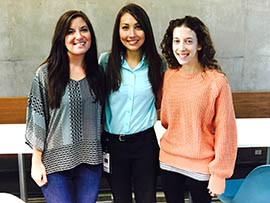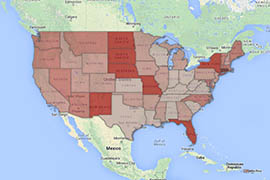Cronkite News has moved to a new home at cronkitenews.azpbs.org. Use this site to search archives from 2011 to May 2015. You can search the new site for current stories.
Programs aim to move med students toward primary care
PHOENIX – Sarah Kellerhals, a second-year medical school student at University of Arizona College of Medicine-Phoenix, says she always knew she wanted to be a primary care doctor rather than specializing in a more lucrative area such as cardiology.
“My parents were in the medical field; my dad was a physician’s assistant and my mom was a nurse, and I just kind of always was interested in medicine,” Kellerhals said.
When both of her parents were diagnosed with cancer within six months of each other while she was a pre-med undergraduate student, it only strengthened her passion for the field, she said.
“I wanted to know more about it, I wanted to learn more about the human body,” Kellerhals said. “I also really enjoyed taking care of them and helping them and I figured that medicine is a great way to continuing caring and helping people.”
Arizona doesn’t have enough primary care physicians to meet the need in many areas, particularly in rural and underserved parts of the state. According to a study by the Henry J. Kaiser Family Foundation that also considered dentists and mental health professionals, only 53 percent of Arizona’s primary health care needs are being met.
To combat the problem, UA medical students held a Primary Care Week recently, offering speakers and events to promote the speciality of primary health care and address reservations students may have about entering the field.
Kellerhals, who helped organize the event, said primary care isn’t a popular choice among students these days, in large part because of lower salaries versus the high cost of attending medical school.
“Medical school is getting more and more expensive,” Kellerhals said. “I do think that a fear that a lot of medical students have is being able to pay off their loans.”
Ana Roscetti, workforce section manager for the Arizona Department of Health Services, said loan-repayment options through the state and federal governments can make primary care more attractive for medical students.
The National Health Services Corps Loan Repayment Program primary care physicians, dentists and mental health professionals $50,000 in financial assistance annually. In exchange, they must sign a two-year contract with a clinic in an underserved area. Primary care professionals can choose to renew their contracts and receive funding until their student loans are paid in full.
The Arizona Loan Repayment Program is similar. Primary care professionals can receive up to $32,000-$40,000 for a two-year commitment, but they can only renew their contracts and receive financial assistance for four years.
“Loan-repayment programs are one of the approaches we are using to at least alleviate some of the burden of school loans for providers who are choosing to work as a primary care provider in a rural underserved community,” Roscetti said.
Kellerhals’ colleague, Alyssa Korenstein, said not making enough money as a “frontline physician” is a big misconception that primary care week addressed.
“Hopefully we can kind of raise awareness that you know, you’re not going to live in a cardboard box if you go into primary care,” Korenstein said.
Kellerhals said another reason why medical students are questioning the specialty of primary care is they view the field as dull.
“Some people want more high-intensity, short-term, and that is not necessarily what is always found in primary care, ” she said.
Another UA medical student, Megan Fah, said the need for primary care doctors is growing both locally and nationally.
“With the changes that have been made in health care, the Affordable Care Act, so many more people are now insured,” she said. “They need a doctor they need a family doc who they can see regularly, and it is a major problem that we have,” Fah said.
“It’s a great thing that we have so many thousands of patients who are now insured, but it’s a problem that we don’t have enough doctors,” she added.
Dr. Steven R. Brown, program director of Banner Good Samaritan Family Medicine Residency, said Arizona is ranked 43rd in the nation for primary care physicians per capita.
“We would need almost 2,000 more primary care physicians by 2030, which would be a 50 percent increase of what we have right now, just to maintain the current level or ratio of primary care physicians, which is already too low,” Brown said.
That’s a shame, he said, because he loves working as a primary care physician.
“I work with the entire family, I deliver babies, work with old people, I work with pregnant women,” Brown said. “I take care of the patient that has the disease not the disease the patient has.”
And that is exactly the kind of experience that Kellerhals said she is looking for.
“I feel like I would do the most good in primary care because our country needs it, and that is where prevention starts,” she said.








